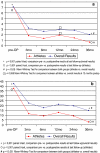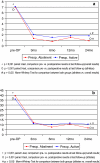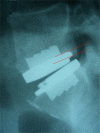Total lumbar disc replacement in athletes: clinical results, return to sport and athletic performance
- PMID: 17205239
- PMCID: PMC2219656
- DOI: 10.1007/s00586-006-0257-y
Total lumbar disc replacement in athletes: clinical results, return to sport and athletic performance
Abstract
Despite the increasing popularity of total lumbar disc replacement (TDR) in predominantly young and active patients, no previous study has addressed possibilities, limitations and potential risks regarding athletic performance following TDR. Mechanical concerns remain and the implant's resilience as regards its load-bearing capacity during sporting activities is unknown. Thirty-nine athletic patients fulfilled the inclusion criteria for this study. These patients participated in a large variety of different types of sport. Significant and lasting pain-relief was attained following TDR with a mean follow-up of 26.3 months (range 9-50.7 months; FU rate 97.4%). Sporting activity was resumed within the first 3 months (38.5%) to 6 months (30.7%) with peak performance being reached after 5.2 months. Thirty-seven patients (94.9%) achieved resumption of sporting activity. Athletic performance improved significantly in 33 patients (84.6%). Minor subsidence was observed in 13 patients (30%) within the first 3 months with no further implant migration thereafter in 12 patients. Participation in all types of sport recorded in this study was accessible for a high rate of patients up to the level of professional athletes as well as those participating in extreme sports. Preoperative participation in sport proved to be a strong positive predictor for highly satisfactory postoperative outcome following TDR. In a selected group of patients, however, preoperative inability to participate in sporting activities did not impair postoperative physical activity. Due to the young age of the patients and significant load increase exerted during athletic activities, persisting concerns regarding the future behaviour of the implant remain and will require longer follow-up, modified investigation techniques and larger patient cohorts.
Figures




Similar articles
-
Clinical results of total lumbar disc replacement with ProDisc II: three-year results for different indications.Spine (Phila Pa 1976). 2006 Aug 1;31(17):1923-32. doi: 10.1097/01.brs.0000228780.06569.e8. Spine (Phila Pa 1976). 2006. PMID: 16924209
-
Dynamics of improvement following total lumbar disc replacement: is the outcome predictable?Spine (Phila Pa 1976). 2009 Nov 1;34(23):2579-86. doi: 10.1097/BRS.0b013e3181b612bd. Spine (Phila Pa 1976). 2009. PMID: 19927108
-
Total lumbar disc replacement: different results for different levels.Spine (Phila Pa 1976). 2007 Apr 1;32(7):782-90. doi: 10.1097/01.brs.0000259071.64027.04. Spine (Phila Pa 1976). 2007. PMID: 17414914 Clinical Trial.
-
Lumbar total disc replacement. Surgical technique.J Bone Joint Surg Am. 2006 Mar;88 Suppl 1 Pt 1:50-64. doi: 10.2106/JBJS.E.01066. J Bone Joint Surg Am. 2006. PMID: 16510800 Review.
-
Total lumbar disc replacement.J Bone Joint Surg Br. 2005 Aug;87(8):1029-37. doi: 10.1302/0301-620X.87B8.16151. J Bone Joint Surg Br. 2005. PMID: 16049234 Review. No abstract available.
Cited by
-
Failure of lumbar disc surgery: management by fusion or arthroplasty?Int Orthop. 2019 Apr;43(4):981-986. doi: 10.1007/s00264-018-4228-9. Epub 2018 Nov 13. Int Orthop. 2019. PMID: 30426178 Review.
-
Return to Work Guidelines Following Neurosurgical Procedures.Cureus. 2020 Dec 8;12(12):e11982. doi: 10.7759/cureus.11982. Cureus. 2020. PMID: 33425552 Free PMC article.
-
We Need to Talk about Lumbar Total Disc Replacement.Int J Spine Surg. 2018 Aug 3;12(2):201-240. doi: 10.14444/5029. eCollection 2018 Apr. Int J Spine Surg. 2018. PMID: 30276080 Free PMC article.
-
Analysis of post-operative pain patterns following total lumbar disc replacement: results from fluoroscopically guided spine infiltrations.Eur Spine J. 2008 Jan;17(1):44-56. doi: 10.1007/s00586-007-0519-3. Epub 2007 Oct 31. Eur Spine J. 2008. PMID: 17972116 Free PMC article.
-
Does vertebral endplate morphology influence outcomes in lumbar disc arthroplasty? Part I: an initial assessment of a novel classification system of lumbar endplate morphology.SAS J. 2008 Mar 1;2(1):16-22. doi: 10.1016/SASJ-2007-0118-RR. eCollection 2008. SAS J. 2008. PMID: 25802597 Free PMC article.
References
-
- Bahr R, Andersen SO, Loken S, Fossan B, Hansen T, Holme I. Low back pain among endurance athletes with and without specific back loading—a cross-sectional survey of cross-country skiers, rowers, orienteerers, and nonathletic controls. Spine. 2004;29:449–454. doi: 10.1097/01.BRS.0000096176.92881.37. - DOI - PubMed
-
- Bertagnoli R, Marnay T, Mayer HM (eds) (2003) Spine Solutions GmbH. The ProDisc Book, Tuttlingen
-
- Bertagnoli R, Yue JJ, Shah RV, Nanieva R, Pfeiffer F, Fenk-Mayer A, Kershaw T, Husted DS. The treatment of disabling multilevel lumbar discogenic low back pain with total disc arthroplasty utilizing the ProDisc prosthesis: a prospective study with 2-year minimum follow-up. Spine. 2005;30:2192–2199. doi: 10.1097/01.brs.0000181061.43194.18. - DOI - PubMed
Publication types
MeSH terms
LinkOut - more resources
Full Text Sources
Medical

